Dosing & Uses
Dosage Forms & Strengths
capsule or tablet, immediate-release (generic)
- 100mg
syrup (generic)
- 50mg/5mL
capsule, extended-release (Gocovri)
- 68.5mg
- 137mg
tablet, extended-release (Osmolex ER)
- 129mg
- 193mg
- 258mg
Parkinson Disease
Immediate-release tablet/capsule or syrup
- Indicated for the treatment of idiopathic Parkinson disease (Paralysis Agitans), postencephalitic Parkinsonism, and symptomatic Parkinsonism which may follow injury to the nervous system by carbon monoxide intoxication
- Monotherapy: 100 mg/day PO initially; may be increased to 100 mg q12hr after at least 1 week; may increase dose up to 400 mg/day in divided doses
- Serious concomitant illness or those receiving high doses of other antiparkinson drugs: 100 mg PO qDay; may increase to 100 mg q12hr, if needed, after one to several week
Extended-release tablet (Osmolex ER)
- Indicated for treatment of Parkinson disease
- 129 mg PO qDay qAM initially; may increase dose in weekly intervals, not to exceed 322 mg/day (one 129-mg and 193-mg tablet)
- For patients unable to tolerate >100 mg/day of immediate-release amantadine, there is no equivalent dose or dosing regimen of extended-release tablets
Extended-release capsule (Gocovri)
- Indicated for adjunctive treatment to levodopa/carbidopa for Parkinson disease in patients experiencing “off” episodes
- 137 mg PO qHS; increase to recommended dose of 274 mg PO qHS after 1 week
Dyskinesia Associated with Parkinson Disease
Gocovri only
Indicated for dyskinesia in patients with Parkinson disease receiving levodopa-based therapy, with or without concomitant dopaminergic medications
137 mg PO qHS; increase to recommended dose of 274 mg PO qHS after 1 week
Drug-induced Extrapyramidal Symptoms
Indicated in the treatment of drug-induced extrapyramidal reactions
Immediate-release tablet/capsule or syrup
- 100 mg PO q12hr; not to exceed 300 mg/day
Extended-release tablet (Osmolex ER)
- 129 mg PO qDay qAM initially; may increase dose in weekly intervals, not to exceed 322 mg/day (one 129-mg and 193-mg tablet)
- For patients unable to tolerate >100 mg/day of immediate-release amantadine, there is no equivalent dose or dosing regimen of extended-release tablets
Influenza A Prophylaxis or Treatment
Immediate-release tablet/capsule or syrup only
NOTE: Because of resistance, amantadine is no longer recommended for prophylaxis or treatment of influenza A; refer to current CDC recommendations
200 mg PO as a single daily dose; may split daily dosage to one 100 mg q12hr; if central nervous system effects develop in once-a-day dosage, a split dosage schedule may reduce such complaints
Dosage Modifications
Renal impairment
-
Immediate-release tablet/capsule or syrup
- CrCl 30-50 mL/min: 200 mg PO on 1st day, then 100 mg/day PO
- CrCl 15-29 mL/min: 200 mg PO on 1st day, then 100 mg PO every other day
- CrCl <15 mL/min or hemodialysis: 200 mg PO weekly
-
Extended-release capsule (Gocovri)
- Mild (CrCl 60-89 ml/min/1.73 m2): No dosage adjustment necessary
- Moderate (CrCl 30-59 mL/min/1.73m2): 68.5 mg qHS initially; may increase to 137 mg qHS after 1 week if necessary; not to exceed 137 mg qHS
- Severe (CrCl 15-29 mL/min/1.73m2): 68.5 mg qHS
- End-stage renal disease (CrCl <15 mL/min/1.73m2): Contraindicated
- Hemodialysis: Inefficiently removed
-
Extended-release tablet (Osmolex ER)
- No modifications for the recommended initial and maximum dose in renal impairment; however, modifications are recommended for the titration interval and frequency of dosing in patients with moderate and severe renal impairment
- Mild (CrCl 60-89 mL/min/1.73 m2): May increase dose weekly; take 1 dose qDay
- Moderate (CrCl 30-59 mL/min/1.73 m2): May increase q3Weeks; take 1 dose q48hr
- Severe (CrCl 15-29 mL/min/1.73 m2): May increase q4Weeks; take 1 dose q96hr
- End-stage renal disease (CrCl<15 mL/min/1.73 m2): Contraindicated
- Monitor changes in renal function, especially in those with severe renal impairment receiving a daily dosage of 322 mg
Dosing Considerations
Amantadine immediate- or extended-release products are not interchangeable
Concomitant use of alcohol when using amantadine extended-release is not recommended owing to increased CNS effects and may result in dose-dumping
Osmolex ER: Do not discontinue abruptly; gradually reduce dose from higher doses to 129 mg daily for 1-2 weeks before discontinuing
Gocovri: Do not discontinue abruptly; to stop therapy in patients who have been on the drug for more than 4 weeks, their dose should typically, if possible, be reduced by half for their final week of dosing
Dosage Forms & Strengths
capsule or tablet, immediate-release (generic)
- 100mg
syrup (generic)
- 50mg/5mL
Influenza A Prophylaxis or Treatment
NOTE: Because of resistance, amantadine is no longer recommended for prophylaxis or treatment of influenza A; refer to current CDC recommendations
1-9 years: 2-4 mg/kg/day PO in single dose or divided q12 hr; not to exceed 150 mg/day
9-12 years: 100 mg PO q12hr; 100 mg/day has not been studied in this pediatric population; continue treatment for at least 10 days following a known exposure
Parkinson Disease
>65 years: Therapy should be based on renal function
Influenza A Prophylaxis or Treatment
≥65 years: 100 mg PO as a single dose
Interactions
Interaction Checker
No Results

Contraindicated
Serious - Use Alternative
Significant - Monitor Closely
Minor

Contraindicated (0)
Serious - Use Alternative (10)
- amisulpride
amisulpride, amantadine. Either decreases effects of the other by pharmacodynamic antagonism. Avoid or Use Alternate Drug. Avoid use of amisulpride, a dopamine receptor antagonist, with dopamine agonists.
- ethanol
ethanol will increase the level or effect of amantadine by Other (see comment). Avoid or Use Alternate Drug. Coadministration of amantadine with alcohol is not recommended, as it may increase the potential for CNS effects such as dizziness, confusion, lightheadedness, and orthostatic hypotension. Alcohol may result in dose-dumping if coadministered with extended-release amantadine.
- influenza virus vaccine quadrivalent, intranasal
amantadine, influenza virus vaccine quadrivalent, intranasal. Other (see comment). Avoid or Use Alternate Drug. Comment: Because of its antiviral properties, amantadine may interfere with the efficacy of live attenuated influenza vaccines (LAIV). Coadministration of LAIV and amantadine is not recommended. Inactivated influenza vaccines may be used, as appropriate.
- mefloquine
mefloquine increases toxicity of amantadine by QTc interval. Avoid or Use Alternate Drug. Mefloquine may enhance the QTc prolonging effect of high risk QTc prolonging agents.
- metoclopramide intranasal
metoclopramide intranasal, amantadine. dopaminergic effects. Avoid or Use Alternate Drug. Opposing effects of metoclopramide and the interacting drug on dopamine. Potential exacerbation of symptoms (eg, parkinsonian symptoms) or decreased therapeutic effects of metoclopramide.
- olanzapine/samidorphan
amantadine increases and olanzapine/samidorphan decreases dopaminergic effects. Effect of interaction is not clear, use caution. Avoid or Use Alternate Drug.
- olopatadine intranasal
amantadine and olopatadine intranasal both increase sedation. Avoid or Use Alternate Drug. Coadministration increases risk of CNS depression, which can lead to additive impairment of psychomotor performance and cause daytime impairment.
- tafenoquine
tafenoquine will increase the level or effect of amantadine by Other (see comment). Avoid or Use Alternate Drug. Tafenoquine inhibits organic cation transporter-2 (OCT2) and multidrug and toxin extrusion (MATE) transporters in vitro. Avoid coadministration with OCT2 or MATE substrates. If coadministration cannot be avoided, monitor for substrate-related toxicities and consider dosage reduction if needed based on product labeling of the coadministered drug.
- trilaciclib
trilaciclib will increase the level or effect of amantadine by Other (see comment). Avoid or Use Alternate Drug. Avoid coadministration of trilaciclib (OCT2, MATE1, and MATE-2K inhibitor) with substrates where minimal increased concentration in kidney or blood may lead to serious or life-threatening toxicities.
- zuranolone
amantadine, zuranolone. Either increases effects of the other by pharmacodynamic synergism. Avoid or Use Alternate Drug. Coadministration of zuranolone with other CNS depressants may increase impairment of psychomotor performance or CNS depressant effects. If unavoidable, consider dose reduction. .
Monitor Closely (61)
- acetazolamide
acetazolamide will decrease the level or effect of amantadine by Other (see comment). Modify Therapy/Monitor Closely. Excretion rate of amantadine increases rapidly when urine is acidic, administration of urine acidifying drugs may increase elimination of amantadine from the body. Monitor for efficacy of amantadine.
- aclidinium
aclidinium, amantadine. Mechanism: pharmacodynamic synergism. Use Caution/Monitor. Potential for increased anticholinergic adverse effects.
- amifampridine
amantadine increases toxicity of amifampridine by Other (see comment). Modify Therapy/Monitor Closely. Comment: Amifampridine can cause seizures. Coadministration with drugs that lower seizure threshold may increase this risk.
- anticholinergic/sedative combos
anticholinergic/sedative combos, amantadine. Mechanism: pharmacodynamic synergism. Use Caution/Monitor. Potential for increased anticholinergic adverse effects.
- atropine
atropine, amantadine. Mechanism: pharmacodynamic synergism. Use Caution/Monitor. Potential for increased anticholinergic adverse effects.
- atropine IV/IM
atropine IV/IM, amantadine. Mechanism: pharmacodynamic synergism. Use Caution/Monitor. Enhanced CNS side effects.
- belladonna alkaloids
belladonna alkaloids, amantadine. Mechanism: pharmacodynamic synergism. Use Caution/Monitor. Potential for increased anticholinergic adverse effects.
- belladonna and opium
belladonna and opium, amantadine. Mechanism: pharmacodynamic synergism. Use Caution/Monitor. Potential for increased anticholinergic adverse effects.
- benztropine
benztropine, amantadine. Mechanism: pharmacodynamic synergism. Use Caution/Monitor. Potential for increased anticholinergic adverse effects.
- brinzolamide
brinzolamide will decrease the level or effect of amantadine by Other (see comment). Modify Therapy/Monitor Closely. Excretion rate of amantadine increases rapidly when urine is acidic, administration of urine acidifying drugs may increase elimination of amantadine from the body. Monitor for efficacy of amantadine.
- bupropion
amantadine, bupropion. Mechanism: pharmacodynamic synergism. Use Caution/Monitor. Potential CNS toxicity d/t synergistic central dopamine effect.
- calcium acetate
calcium acetate will increase the level or effect of amantadine by Other (see comment). Modify Therapy/Monitor Closely. Urine pH changes towards alkalinic conditions may lead to an accumulation of amantadine with a possible increase in adverse reactions. Monitor for adverse reactions of amantadine.
- calcium carbonate
calcium carbonate will increase the level or effect of amantadine by Other (see comment). Modify Therapy/Monitor Closely. Urine pH changes towards alkalinic conditions may lead to an accumulation of amantadine with a possible increase in adverse reactions. Monitor for adverse reactions of amantadine.
- calcium citrate
calcium citrate will increase the level or effect of amantadine by Other (see comment). Modify Therapy/Monitor Closely. Urine pH changes towards alkalinic conditions may lead to an accumulation of amantadine with a possible increase in adverse reactions. Monitor for adverse reactions of amantadine.
- cyclizine
cyclizine, amantadine. Mechanism: pharmacodynamic synergism. Use Caution/Monitor. Potential for increased anticholinergic adverse effects.
- cyclobenzaprine
cyclobenzaprine, amantadine. Mechanism: pharmacodynamic synergism. Use Caution/Monitor. Potential for increased anticholinergic adverse effects.
- daridorexant
amantadine and daridorexant both increase sedation. Modify Therapy/Monitor Closely. Coadministration increases risk of CNS depression, which can lead to additive impairment of psychomotor performance and cause daytime impairment.
- darifenacin
darifenacin, amantadine. Mechanism: pharmacodynamic synergism. Use Caution/Monitor. Potential for increased anticholinergic adverse effects.
- dicyclomine
dicyclomine, amantadine. Mechanism: pharmacodynamic synergism. Use Caution/Monitor. Potential for increased anticholinergic adverse effects.
- difelikefalin
difelikefalin and amantadine both increase sedation. Use Caution/Monitor.
- diphenhydramine
diphenhydramine, amantadine. Mechanism: pharmacodynamic synergism. Use Caution/Monitor. Potential for increased anticholinergic adverse effects.
- dorzolamide
dorzolamide will decrease the level or effect of amantadine by Other (see comment). Modify Therapy/Monitor Closely. Excretion rate of amantadine increases rapidly when urine is acidic, administration of urine acidifying drugs may increase elimination of amantadine from the body. Monitor for efficacy of amantadine.
- erdafitinib
erdafitinib increases levels of amantadine by decreasing renal clearance. Modify Therapy/Monitor Closely. Consider alternatives that are not OCT2 substrates or consider reducing the dose of OCT2 substrates based on tolerability.
- fesoterodine
fesoterodine, amantadine. Mechanism: pharmacodynamic synergism. Use Caution/Monitor. Potential for increased anticholinergic adverse effects.
- flavoxate
flavoxate, amantadine. Mechanism: pharmacodynamic synergism. Use Caution/Monitor. Potential for increased anticholinergic adverse effects.
- givinostat
amantadine and givinostat both increase QTc interval. Use Caution/Monitor. If coadministered, obtain ECGs when initiating, during concomitant use, and as clinically indicated. Withhold if QTc interval >500 ms or a change from baseline >60 ms.
givinostat will increase the level or effect of amantadine by Other (see comment). Use Caution/Monitor. Givinostat is a weak OAT2 inhibitor. Closely monitor if coadministered with orally administered OCT2 sensitive substrates for which a small change in substrate plasma concentration may lead to serious toxicities. - glycopyrrolate
glycopyrrolate, amantadine. Mechanism: pharmacodynamic synergism. Use Caution/Monitor. Potential for increased anticholinergic adverse effects.
- glycopyrrolate inhaled
glycopyrrolate inhaled increases levels of amantadine by unknown mechanism. Use Caution/Monitor.
glycopyrrolate inhaled, amantadine. Mechanism: pharmacodynamic synergism. Use Caution/Monitor. Potential for increased anticholinergic adverse effects. - henbane
henbane, amantadine. Mechanism: pharmacodynamic synergism. Use Caution/Monitor. Enhanced CNS side effects.
- homatropine
homatropine, amantadine. Mechanism: pharmacodynamic synergism. Use Caution/Monitor. Enhanced CNS side effects.
- hyoscyamine
hyoscyamine, amantadine. Mechanism: pharmacodynamic synergism. Use Caution/Monitor. Potential for increased anticholinergic adverse effects.
- hyoscyamine spray
hyoscyamine spray, amantadine. Mechanism: pharmacodynamic synergism. Use Caution/Monitor. Enhanced CNS side effects.
- iloprost
iloprost, amantadine. Either increases effects of the other by pharmacodynamic synergism. Modify Therapy/Monitor Closely. When administering iloprost IV, consider temporary discontinuation of concomitant vasodilators or other medications that reduce blood pressure to mitigate potential additive hypotensive effects. If hypotension persists despite discontinuing other antihypertensives and fluid resuscitation, consider iloprost dose reduction or discontinuation.
- ipratropium
ipratropium, amantadine. Mechanism: pharmacodynamic synergism. Use Caution/Monitor. Potential for increased anticholinergic adverse effects.
- lurasidone
lurasidone increases effects of amantadine by Other (see comment). Use Caution/Monitor. Comment: Antipsychotics may diminish the therapeutic effect of anti-parkinson's agents.
- meclizine
meclizine, amantadine. Mechanism: pharmacodynamic synergism. Use Caution/Monitor. Potential for increased anticholinergic adverse effects.
- memantine
memantine, amantadine. Either increases toxicity of the other by pharmacodynamic synergism. Use Caution/Monitor. Combination may lead to additive adverse effects. If coadministration cannot be avoided, monitor for increased adverse effects such as agitation, dizziness and other CNS events.
- methazolamide
methazolamide will decrease the level or effect of amantadine by Other (see comment). Modify Therapy/Monitor Closely. Excretion rate of amantadine increases rapidly when urine is acidic, administration of urine acidifying drugs may increase elimination of amantadine from the body. Monitor for efficacy of amantadine.
- methscopolamine
methscopolamine, amantadine. Mechanism: pharmacodynamic synergism. Use Caution/Monitor. Potential for increased anticholinergic adverse effects.
- oxybutynin
oxybutynin, amantadine. Mechanism: pharmacodynamic synergism. Use Caution/Monitor. Potential for increased anticholinergic adverse effects.
- oxybutynin topical
oxybutynin topical, amantadine. Mechanism: pharmacodynamic synergism. Use Caution/Monitor. Potential for increased anticholinergic adverse effects.
- oxybutynin transdermal
oxybutynin transdermal, amantadine. Mechanism: pharmacodynamic synergism. Use Caution/Monitor. Potential for increased anticholinergic adverse effects.
- potassium citrate
potassium citrate will increase the level or effect of amantadine by Other (see comment). Modify Therapy/Monitor Closely. Urine pH changes towards alkalinic conditions may lead to an accumulation of amantadine with a possible increase in adverse reactions. Monitor for adverse reactions of amantadine.
- propantheline
propantheline, amantadine. Mechanism: pharmacodynamic synergism. Use Caution/Monitor. Potential for increased anticholinergic adverse effects.
- quinidine
quinidine will increase the level or effect of amantadine by decreasing renal clearance. Use Caution/Monitor. Coadministration of quinine or quinidine with amantadine was shown to reduce the renal clearance of amantadine by ~30%.
- quinine
quinine will increase the level or effect of amantadine by decreasing renal clearance. Use Caution/Monitor. Coadministration of quinine or quinidine with amantadine was shown to reduce the renal clearance of amantadine by ~30%.
- scopolamine
scopolamine, amantadine. Mechanism: pharmacodynamic synergism. Use Caution/Monitor. Potential for increased anticholinergic adverse effects.
- sodium bicarbonate
sodium bicarbonate will increase the level or effect of amantadine by Other (see comment). Modify Therapy/Monitor Closely. Urine pH changes towards alkalinic conditions may lead to an accumulation of amantadine with a possible increase in adverse reactions. Monitor for adverse reactions of amantadine.
- solifenacin
solifenacin, amantadine. Mechanism: pharmacodynamic synergism. Use Caution/Monitor. Potential for increased anticholinergic adverse effects.
- solriamfetol
amantadine and solriamfetol both increase sympathetic (adrenergic) effects, including increased blood pressure and heart rate. Use Caution/Monitor.
- sulfamethoxazole
sulfamethoxazole increases levels of amantadine by decreasing elimination. Use Caution/Monitor. Coadministration may impair renal clearance of amantadine, resulting in higher plasma concentrations.
- tiotropium
tiotropium, amantadine. Mechanism: pharmacodynamic synergism. Use Caution/Monitor. Potential for increased anticholinergic adverse effects.
- tolterodine
tolterodine, amantadine. Mechanism: pharmacodynamic synergism. Use Caution/Monitor. Potential for increased anticholinergic adverse effects.
- triamterene
triamterene increases levels of amantadine by decreasing elimination. Use Caution/Monitor.
- trihexyphenidyl
trihexyphenidyl, amantadine. Mechanism: pharmacodynamic synergism. Use Caution/Monitor. Potential for increased anticholinergic adverse effects.
- trimethoprim
trimethoprim increases levels of amantadine by decreasing elimination. Use Caution/Monitor. Coadministration may impair renal clearance of amantadine, resulting in higher plasma concentrations.
- trospium chloride
trospium chloride, amantadine. Mechanism: pharmacodynamic synergism. Use Caution/Monitor. Potential for increased anticholinergic adverse effects.
- ublituximab
ublituximab decreases effects of amantadine by immunosuppressive effects; risk of infection. Use Caution/Monitor.
- umeclidinium bromide
umeclidinium bromide, amantadine. Mechanism: pharmacodynamic synergism. Use Caution/Monitor. Potential for increased anticholinergic adverse effects.
- umeclidinium bromide/vilanterol inhaled
umeclidinium bromide/vilanterol inhaled, amantadine. Mechanism: pharmacodynamic synergism. Use Caution/Monitor. Potential for increased anticholinergic adverse effects.
- vandetanib
vandetanib increases levels of amantadine by Other (see comment). Modify Therapy/Monitor Closely. Comment: Vandetanib inhibits the uptake of substrates of organic cation transporter type 2 (OCT2).
Minor (20)
- amphetamine
amantadine, amphetamine. Either increases effects of the other by pharmacodynamic synergism. Minor/Significance Unknown. Potential for additive CNS stimulation.
- armodafinil
amantadine, armodafinil. Either increases effects of the other by pharmacodynamic synergism. Minor/Significance Unknown. Potential for additive CNS stimulation.
- atropine IV/IM
atropine IV/IM increases levels of amantadine by unknown mechanism. Minor/Significance Unknown.
- caffeine
amantadine, caffeine. Either increases effects of the other by pharmacodynamic synergism. Minor/Significance Unknown. Potential for additive CNS stimulation.
- dexmethylphenidate
amantadine, dexmethylphenidate. Either increases effects of the other by pharmacodynamic synergism. Minor/Significance Unknown. Potential for additive CNS stimulation.
- dextroamphetamine
amantadine, dextroamphetamine. Either increases effects of the other by pharmacodynamic synergism. Minor/Significance Unknown. Potential for additive CNS stimulation.
- influenza virus vaccine quadrivalent
amantadine decreases effects of influenza virus vaccine quadrivalent by Other (see comment). Minor/Significance Unknown. Comment: Because of its antiviral properties, amantadine may interfere with the efficacy of live attenuated influenza vaccines (LAIV). Coadministration of LAIV and amantadine is not recommended. Inactivated influenza vaccines may be used, as appropriate.
- influenza virus vaccine quadrivalent, cell-cultured
amantadine decreases effects of influenza virus vaccine quadrivalent, cell-cultured by Other (see comment). Minor/Significance Unknown. Comment: Because of its antiviral properties, amantadine may interfere with the efficacy of live attenuated influenza vaccines (LAIV). Coadministration of LAIV and amantadine is not recommended. Inactivated influenza vaccines may be used, as appropriate.
- influenza virus vaccine quadrivalent, recombinant
amantadine decreases levels of influenza virus vaccine quadrivalent, recombinant by Other (see comment). Minor/Significance Unknown. Comment: Because of its antiviral properties, amantadine may interfere with the efficacy of live attenuated influenza vaccines (LAIV). Coadministration of LAIV and amantadine is not recommended. Inactivated influenza vaccines may be used, as appropriate.
- isavuconazonium sulfate
isavuconazonium sulfate will increase the level or effect of amantadine by Other (see comment). Minor/Significance Unknown. Isavuconazonium sulfate, an OCT2 inhibitor, may increase the effects or levels of OCT2 substrates.
- lisdexamfetamine
amantadine, lisdexamfetamine. Either increases effects of the other by pharmacodynamic synergism. Minor/Significance Unknown. Potential for additive CNS stimulation.
- methamphetamine
amantadine, methamphetamine. Either increases effects of the other by pharmacodynamic synergism. Minor/Significance Unknown. Potential for additive CNS stimulation.
- methylphenidate
amantadine, methylphenidate. Either increases effects of the other by pharmacodynamic synergism. Minor/Significance Unknown. Potential for additive CNS stimulation.
- modafinil
amantadine, modafinil. Either increases effects of the other by pharmacodynamic synergism. Minor/Significance Unknown. Potential for additive CNS stimulation.
- oxybutynin
amantadine increases effects of oxybutynin by pharmacodynamic synergism. Minor/Significance Unknown.
- oxybutynin topical
amantadine increases effects of oxybutynin topical by pharmacodynamic synergism. Minor/Significance Unknown.
- oxybutynin transdermal
amantadine increases effects of oxybutynin transdermal by pharmacodynamic synergism. Minor/Significance Unknown.
- phentermine
amantadine, phentermine. Either increases effects of the other by pharmacodynamic synergism. Minor/Significance Unknown. Potential for additive CNS stimulation.
- serdexmethylphenidate/dexmethylphenidate
amantadine, serdexmethylphenidate/dexmethylphenidate. Either increases effects of the other by pharmacodynamic synergism. Minor/Significance Unknown. Potential for additive CNS stimulation.
- thioridazine
amantadine increases toxicity of thioridazine by pharmacodynamic synergism. Minor/Significance Unknown. May increase Parkinsonian tremor.
Adverse Effects
>10%
Extended-release capsule (Gocovri)
- Hallucinations (21%)
- Dizziness (16%)
- Dry mouth (16%)
- Peripheral edema (16%)
- Constipation (13%)
- Fall (13%)
- Orthostatic hypotension (13%)
1-10%
Extended-release capsule (Gocovri)
- Urinary tract infection (10%)
- Nausea (8%)
- Anxiety (7%)
- Insomnia (7%)
- Livedo reticularis (6%)
- Contusion (6%)
- Depression/depressed mood (6%)
- Headache (6%)
- Benign prostate hyperplasia (6%)
- Decreased appetite (6%)
- Abnormal dreams (4%)
- Blurred vision (4%)
- Cough (3%)
- Pigmentation disorder (3%)
- Dystonia (3%)
- Confusional state (3%)
- Vomiting (3%)
- Gait disturbance (3%)
- Cataract (3%)
- Dry eye (3%)
- Joint swelling (3%)
- Muscle spasms (3%)
Immediate-release tablet/capsule or syrup
-
5-10%
- Nausea
- Dizziness/lightheadedness
- Insomnia
-
1-5%
- Depression
- Anxiety and irritability
- Hallucinations
- Confusion
- Anorexia
- Dry mouth
- Constipation
- Ataxia
- Livedo reticularis
- Peripheral edema
- Orthostatic hypotension
- Headache
- Somnolence
- Nervousness
- Dream abnormality
- Agitation
- Dry nose
- Diarrhea
- Fatigue
<1%
Immediate-release tablet/capsule or syrup
- Congestive heart failure
- Psychosis
- Urinary retention
- Dyspnea
- Skin rash
- Vomiting
- Weakness
- Slurred speech
- Euphoria
- Thinking abnormality
- Amnesia
- Hyperkinesia
- Hypertension
- Decreased libido
- Visual disturbance
- Corneal edema
- Decreased visual acuity
- Sensitivity to light
- Optic nerve palsy
- Convulsion
- Leukopenia
- Neutropenia
- Eczematoid dermatitis
- Suicide/ suicide ideation
Postmarketing Reports
Extended-release capsule (Gocovri)
- Seizures
Warnings
Contraindications
Tablet, syrup, capsule
- Hypersensitivity to amantadine, rimantadine
- Untreated narrow-angle glaucoma
- Breastfeeding
Extended-release capsule or tablet
- End-stage renal disease (CrCl<15 mL/min/1.73m²)
Cautions
Reports of falling asleep while engaged in activities of daily living (eg, operation of motor vehicles); patients may not perceive warning signs, such as excessive drowsiness, or they may report feeling alert immediately prior to the event; advise patients of the potential to develop drowsiness
Avoid abrupt withdrawal; abrupt discontinuation of amantadine may cause an increase in symptoms of Parkinson disease or cause delirium, agitation, delusions, hallucinations, paranoid reaction, stupor, anxiety, depression, or slurred speech
In clinical trials, suicidal ideation, depression, and/or depressed mood were reported; monitor for depression, including suicidal ideation or behavior
Tablet, syrup, capsule
- Since 2008-09 influenza season, Centers for Disease Control and Prevention (CDC) advises against use for treatment or prophylaxis of influenza in US
- Reports of congestive heart failure (CHF), peripheral edema, and hypotension with amantadine; monitor patients with history of CHF, peripheral edema, and/or orthostatic hypotension
- Amantadine may accumulate in the plasma and body when renal function declines; see Dosing Considerations
- Rare instances of reversible elevation of liver enzymes have been reported in patients receiving amantadine, though the mechanism is unknown
- History of seizures, eczematoid rash, severe psychosis or psychoneurosis
- Consider reducing anticholinergic dosages before initiating amantadine therapy
- Risk of neuroleptic malignant syndrome (NMS) with dosage reduction or withdrawal; management of NMS should include intensive symptomatic treatment, medical monitoring, and treatment of any concomitant serious medical problems for which specific treatments are available
- Possibility of reduced effectiveness after several months; may regain efficacy if dosage is increased
Extended-release capsule or tablet
- Patients with a major psychotic disorder should ordinarily not be treated with amantadine because of the risk of exacerbating psychosis; observe patients for the occurrence of hallucinations throughout treatment, especially at initiation and after dose increases
- In controlled clinical trials, patients experienced dizziness, syncope, orthostatic hypotension, presyncope, postural dizziness or hypotension; monitor patients for dizziness and orthostatic hypotension, especially after starting amantadine extended-release or increasing the dose
Parkinson patients
- Patients can experience intense urges to gamble, increased sexual urges, intense urges to spend money, binge eating, and/or other intense urges, and inability to control these urges while taking one or more of the medications, including amantadine, that increase central dopaminergic tone
- May be linked to higher melanoma risk; monitor for melanomas frequently and on a regular basis when using amantadine for any indication; periodic skin examinations should be performed by appropriately qualified individuals
Drug interactions overview
Extended-release capsules or tablets
- Products with anticholinergic properties may potentiate anticholinergic-like side effects of amantadine, reduce dose of anticholinergic drugs or of extended-release amantadine if atropine-like effects appear when these drugs are used concurrently
- Since excretion rate of amantadine increases rapidly when urine is acidic, coadministration of urine acidifying drugs may increase elimination of amantadine from the body; alterations of urine pH towards the alkaline condition may lead to drug accumulation with a possible increase in adverse reactions; monitor for efficacy or adverse reactions under conditions that alter the urine pH to more acidic or alkaline, respectively
- Because of its antiviral properties, amantadine may interfere with the efficacy of live attenuated influenza vaccines; live vaccines are not recommended during treatment; inactivated influenza vaccines may be used, as appropriate
- Concomitant use with alcohol is not recommended, as it may potentiate central nervous system effects (eg, somnolence, dizziness, confusion, lightheadedness, and orthostatic hypotension)
Pregnancy & Lactation
Pregnancy
No adequate data on developmental risk associated with amantadine use in pregnant women; animal studies suggest a potential risk for fetal harm with amantadine; in mice and rats, adverse developmental effects (embryo lethality, increased incidence of malformations, and reduced fetal body weight) were observed when amantadine was administered to pregnant animals at clinically relevant doses
In mice, oral administration of amantadine (0, 10, or 40 mg/kg/day) to pregnant animals during organogenesis (gestation days 7-12) resulted in embryo lethality and reduced fetal body weight at highest dose tested, which was associated with maternal toxicity; the no-effect dose for developmental toxicity in mice (10 mg/kg/day) is less than the recommended human dose (RHD) of 274 mg/day, based on body surface area (mg/m²)
Lactation
Amantadine is excreted into human milk, but amounts have not been quantified; there is no information on the risk to a breastfed infant; amantadine may alter breast milk production or excretion
In published studies, amantadine reduced serum prolactin levels and symptoms of galactorrhea in patients taking neuroleptic drugs; the effect of amantadine on milk supply has not been evaluated in nursing mothers
Pregnancy Categories
A: Generally acceptable. Controlled studies in pregnant women show no evidence of fetal risk.
B: May be acceptable. Either animal studies show no risk but human studies not available or animal studies showed minor risks and human studies done and showed no risk. C: Use with caution if benefits outweigh risks. Animal studies show risk and human studies not available or neither animal nor human studies done. D: Use in LIFE-THREATENING emergencies when no safer drug available. Positive evidence of human fetal risk. X: Do not use in pregnancy. Risks involved outweigh potential benefits. Safer alternatives exist. NA: Information not available.Pharmacology
Mechanism of Action
Antiviral
- The mechanism of antiviral activity is unknown; appears to primarily prevent the release of infectious viral nucleic acid into the host cell by interfering with transmembrane domain of viral M2 protein; amantadine is also known to prevent viral assembly during replication and inhibits replication of influenza A virus isolates from each of the subtypes (ie, H1N1, H2N2 and H3N2), but has very little or no activity against influenza B virus isolates
Parkinson disease
- The exact mechanism of amantadine in the treatment of Parkinson disease, drug-induced extrapyramidal reactions, dyskinesia associated with Parkinson disease is not known; amantadine is a weak, noncompetitive NMDA receptor antagonist
- Data from early animal studies suggest that amantadine may have direct and indirect effects on dopamine neurons; amantadine may have direct and indirect effects on dopamine neurons; it exerts dopaminergic-like side effects (eg, hallucinations and dizziness) in humans; although amantadine has not been shown to possess direct anticholinergic activity, clinically, it exhibits anticholinergic-like side effects (eg, dry mouth, urinary retention, and constipation)
Absorption
Bioavailability: 86-90%
Onset: Within 48 hr (antidyskinetic)
Peak plasma time: 2-4 hr (capsule, tablets, syrup); 12 hr (extended-release capsule)
Peak plasma concentration : 0.24 mcg/mL (100-mg single dose); 328 ng/mL (129-mg single extended-release tablet dose)
AUC : 20-30% higher (steady-state for single ER capsule dose); 8263 ng·hr/mL (129-mg single extended-release tablet dose)
Distribution
Protein bound: 67%
Vd: 1.5-6.1 L/kg (capsule, tablet, syrup); 3-8 L/kg (IV administration)
Metabolism
Not appreciably metabolized; small amounts of acetyl metabolite identified
Elimination
Half-life: 16 hr
Clearance: 0.2-0.3 L/hr/kg (capsule, tablet, syrup); 0.27 L/hr/kg (capsule, ER)
Excretion: Urine (80-90% unchanged) by glomerular filtration and tubular secretion
Excretion, extended-release tablets: Urine (85% [unchanged]; 0-15% (N-acetylated compound)
Metabolism accounts for 5-18% total clearance of amantadine
Urine pH reported to influence excretion rate of amantadine
Administration
Oral Administration
Administer daily dose in 2 divided doses to decrease adverse CNS effects
Administer 2nd dose several hours before bedtime to minimize insomnia
Amantadine immediate- or extended-release products are not interchangeable
Extended-release capsule
Administer with or without food
Swallow capsule whole; do not crush, chew, or divide capsules
Missed dose: Take next dose as scheduled
-
Unable to swallow capsule
- Administer by carefully opening and sprinkling the entire contents on small amount (teaspoonful) of soft food, such as applesauce; drug/food mixture should be swallowed immediately without chewing
- Do not store mixture for future use
Extended-release tablet
- Swallow capsule whole
- Do not chew, crush, or divide tablets; administered without regard to food
- Missed dose: Take next dose as scheduled
Storage
All formulations: Store at 20-25°C (68-77°F); excursions permitted to 15-30°C (59-86°F)
Images
| BRAND | FORM. | UNIT PRICE | PILL IMAGE |
|---|---|---|---|
| amantadine HCl oral - | 100 mg capsule | 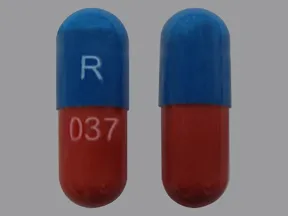 | |
| amantadine HCl oral - | 100 mg capsule | 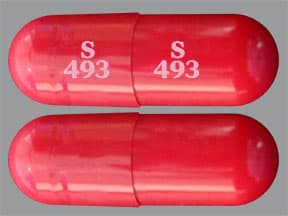 | |
| amantadine HCl oral - | 100 mg capsule | 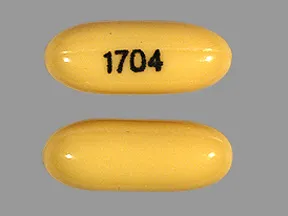 | |
| amantadine HCl oral - | 100 mg capsule |  | |
| amantadine HCl oral - | 100 mg capsule | 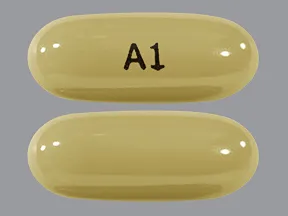 | |
| amantadine HCl oral - | 100 mg tablet | 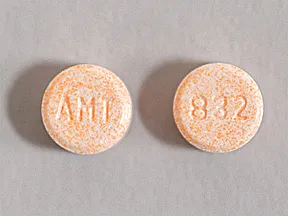 | |
| amantadine HCl oral - | 100 mg capsule | 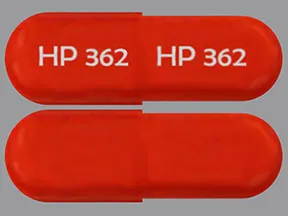 | |
| amantadine HCl oral - | 100 mg capsule |  | |
| amantadine HCl oral - | 100 mg tablet | 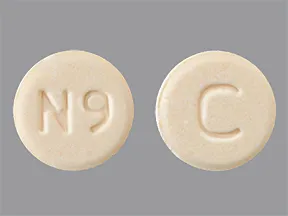 | |
| amantadine HCl oral - | 50 mg/5 mL solution |  | |
| amantadine HCl oral - | 100 mg tablet |  | |
| amantadine HCl oral - | 100 mg tablet |  | |
| amantadine HCl oral - | 50 mg/5 mL solution | 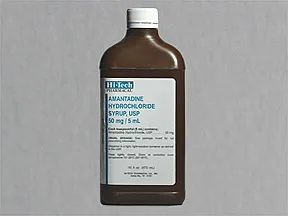 | |
| amantadine HCl oral - | 100 mg tablet |  | |
| amantadine HCl oral - | 100 mg capsule |  | |
| amantadine HCl oral - | 50 mg/5 mL solution | 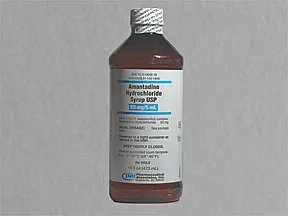 | |
| amantadine HCl oral - | 50 mg/5 mL solution |  | |
| Gocovri oral - | 137 mg capsule |  | |
| Gocovri oral - | 68.5 mg capsule |  |
Copyright © 2010 First DataBank, Inc.
Patient Handout
amantadine HCl oral
AMANTADINE EXTENDED-RELEASE - ORAL
(a-MAN-ta-deen)
COMMON BRAND NAME(S): Gocovri, Osmolex ER
USES: This medication is used to treat Parkinson's disease. It is also used to treat certain movement disorders caused by some drugs (extrapyramidal reactions). This medication is thought to work by restoring the balance of certain natural substances (neurotransmitters) in the brain.Different brands of this medication may have different uses. Do not change brands of this medication unless directed by your doctor.
HOW TO USE: Take this medication by mouth with or without food as directed by your doctor, usually once daily. Ask your doctor or pharmacist when to take your medication since different brands are taken at different times (either in the morning, or at bedtime). Swallow this medication whole. Do not crush, chew, or split the capsules/tablets. Doing so can release all of the drug at once, increasing the risk of side effects.If you using the capsules and have trouble swallowing them whole, you may open the capsule and sprinkle the contents on a small amount of soft food (such as applesauce) just before taking. Swallow the mixture right away without chewing. Do not save it to take later.The dosage is based on your medical condition and response to treatment.Use this medication regularly to get the most benefit from it. To help you remember, take it at the same time each day.Do not stop taking this medication without consulting your doctor. Your condition may get worse if this drug is suddenly stopped or if your dose is quickly decreased. Your doctor may gradually reduce your dose to lessen the chance of symptoms such as agitation, anxiety, hallucinations, depression, or trouble speaking. Tell your doctor right away of any new or worsening symptoms.Amantadine may take several weeks to have an effect. Tell your doctor if your condition does not get better or if it gets worse.
SIDE EFFECTS: Blurred vision, nausea, loss of appetite, drowsiness, dizziness, lightheadedness, headache, dry mouth, constipation, or trouble sleeping may occur. If any of these effects last or get worse, tell your doctor or pharmacist promptly.Dizziness and lightheadedness can increase the risk of falling. Get up slowly when rising from a sitting or lying position.To relieve dry mouth, suck (sugarless) hard candy or ice chips, chew (sugarless) gum, drink water, or use a saliva substitute.If you are taking the extended-release tablets, an empty tablet shell may appear in your stool. This effect is harmless because your body has already absorbed the medication.Remember that this medication has been prescribed because your doctor has judged that the benefit to you is greater than the risk of side effects. Many people using this medication do not have serious side effects.Tell your doctor right away if you have any serious side effects, including: purplish-red blotchy spots on the skin (especially on the legs), swelling of the ankles/feet, difficulty urinating, vision changes, unusual strong urges (such as increased gambling, increased sexual urges, uncontrolled spending), mental/mood changes (such as anxiety, depression, hallucinations, suicidal thoughts/attempts), muscle spasms.Get medical help right away if you have any very serious side effects, including: seizure.Some people taking amantadine have fallen asleep suddenly during their usual daily activities (such as talking, driving). You might fall asleep without warning or without feeling drowsy. This effect can happen at any time even if you have used this medication for a long time. If you have increased sleepiness or fall asleep suddenly during the day, tell your doctor right away. Your risk is higher if you drink alcohol or take other medications that can make you drowsy. Do not drive or do other activities for which you need to be alert (see also Precautions section).A very serious allergic reaction to this drug is rare. However, get medical help right away if you notice any symptoms of a serious allergic reaction, including: rash, itching/swelling (especially of the face/tongue/throat), severe dizziness, trouble breathing.This is not a complete list of possible side effects. If you notice other effects not listed above, contact your doctor or pharmacist.In the US -Call your doctor for medical advice about side effects. You may report side effects to FDA at 1-800-FDA-1088 or at www.fda.gov/medwatch.In Canada - Call your doctor for medical advice about side effects. You may report side effects to Health Canada at 1-866-234-2345.
PRECAUTIONS: Before taking amantadine, tell your doctor or pharmacist if you are allergic to it; or to rimantadine; or if you have any other allergies. This product may contain inactive ingredients, which can cause allergic reactions or other problems. Talk to your pharmacist for more details.Before using this medication, tell your doctor or pharmacist your medical history, especially of: glaucoma, kidney disease, mental/mood conditions (such as depression, psychosis), a certain skin disorder (eczematoid dermatitis), sleep disorders (such as narcolepsy), seizure disorder.This drug may make you dizzy or drowsy or blur your vision. Alcohol or marijuana (cannabis) can make you more dizzy or drowsy. Do not drive, use machinery, or do anything that needs alertness or clear vision until you can do it safely. Limit alcoholic beverages. Talk to your doctor if you are using marijuana (cannabis).Before having surgery, tell your doctor or dentist about all the products you use (including prescription drugs, nonprescription drugs, and herbal products).Older adults may be more sensitive to the side effects of this drug, especially dizziness, lightheadedness, and mental/mood changes (such as hallucinations). Dizziness and lightheadedness can increase the risk of falling.During pregnancy, this medication should be used only when clearly needed. Discuss the risks and benefits with your doctor.This drug passes into breast milk and may have undesirable effects on a nursing infant. Consult with your doctor before breastfeeding.
DRUG INTERACTIONS: Drug interactions may change how your medications work or increase your risk for serious side effects. This document does not contain all possible drug interactions. Keep a list of all the products you use (including prescription/nonprescription drugs and herbal products) and share it with your doctor and pharmacist. Do not start, stop, or change the dosage of any medicines without your doctor's approval.Amantadine may interfere with the effect of certain vaccines, such as flu vaccine inhaled through the nose. However, you may get a flu shot (flu vaccine given by injection) if recommended by your doctor.
OVERDOSE: If someone has overdosed and has serious symptoms such as passing out or trouble breathing, call 911. Otherwise, call a poison control center right away. US residents can call 1-800-222-1222. Canada residents can call 1-844-764-7669. Symptoms of overdose may include fast/irregular heartbeat, severe drowsiness, shortness of breath, change in the amount of urine, mental/mood changes (such as anxiety, aggression, confusion, hallucinations), seizure.
NOTES: Do not share this medication with others.
MISSED DOSE: If you miss a dose, skip the missed dose. Take your next dose at the regular time. Do not double the dose to catch up.
STORAGE: Store at room temperature away from light and moisture. Do not store in the bathroom. Keep all medications away from children and pets.Do not flush medications down the toilet or pour them into a drain unless instructed to do so. Properly discard this product when it is expired or no longer needed. Consult your pharmacist or local waste disposal company.
Information last revised May 2024. Copyright(c) 2024 First Databank, Inc.
IMPORTANT: HOW TO USE THIS INFORMATION: This is a summary and does NOT have all possible information about this product. This information does not assure that this product is safe, effective, or appropriate for you. This information is not individual medical advice and does not substitute for the advice of your health care professional. Always ask your health care professional for complete information about this product and your specific health needs.
Formulary
Adding plans allows you to compare formulary status to other drugs in the same class.
To view formulary information first create a list of plans. Your list will be saved and can be edited at any time.
Adding plans allows you to:
- View the formulary and any restrictions for each plan.
- Manage and view all your plans together – even plans in different states.
- Compare formulary status to other drugs in the same class.
- Access your plan list on any device – mobile or desktop.







